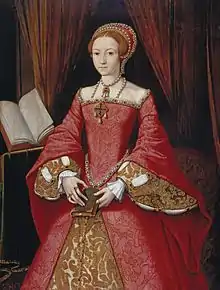French hood
The French hood is a type of woman's headgear that was popular in Western Europe in the 16th century.
_-_Portrait_of_a_lady%252C_probably_of_the_Cromwell_Family_formerly_known_as_Catherine_Howard_-_WGA11565.jpg.webp)
The French hood is characterized by a rounded shape, contrasted with the angular "English" or gable hood. It is worn over a coif, and has a black veil attached to the back, which fully covers the hair.[1] Unlike the more conservative gable hood, it displays the front part of the hair.
History
The origins of the French hood can be seen in portraits of Anne of Brittany in the early 1500s. Although popularly associated with Anne Boleyn, it was probably introduced to the English court by Mary Tudor, Queen of France, who is depicted wearing one in a wedding portrait from around 1516.[2] Catherine of Aragon bought a French hood for her daughter Mary in March 1520.[3] However, English women at the time mostly wore the gable hood, and so it did not achieve much popularity in England until the 1530s and 1540s. According the Chronicle of the Grey Friars, the French hood and the jewelled gold billament became popular when Anne of Cleves came to England in 1540.[4] Most examples from this period can be seen in depictions of women who were in service to one of Henry VIII's wives, implying that it was primarily a court fashion.[5]
In September 1537, Lady Lisle, a Tudor noblewoman whose correspondence is widely documented, requested from the merchant William le Gras: "many hats, such as the ladies wear in France, for now the ladies here follow the French fashion."[6] Despite its growth in popularity, the then-Queen Jane Seymour apparently forbade her ladies from wearing the French hood. John Husee informed Lady Lisle that her daughter, an attendant to the Queen, was required to instead wear a "bonnet and frontlet of velvet", lamenting that it "became her nothing so well as the French hood."[6] As the century progressed, the French hood became smaller and more curved, and was worn further back on the head.
Habilments or billaments
The front of hood could be decorated with a jewelled band, in England called a "habilment or "billement", (see below). In the early 1540s, Henry VIII passed a sumptuary law restricting the usage of "any Frenche hood or bonnet of velvett with any habiliment, paste, or egg [edge] of gold, pearl, or stone" to the wives of men with at least one horse.[5]
Mary I of England gave gold billaments to some of her gentlewomen to wear at her coronation in 1553.[7] The inventories of the jewels of Mary, Queen of Scots, include several pairs of jewelled "billiments" worn at the front of a hood.[8] They were described using a French word, bordure.[9] Sources written in Scots call these accessories "garnishings".[10]
Construction
The various elements of the French hood are as follows:
- Coif – Made of linen, tied under the chin or possibly secured to the hair with pins, the coif was almost always white from the first quarter of the 16th century onward, with a fashion for early French hoods having red coifs existing prior to 1520.
- Crepine – A pleated or gathered head covering made from fine linen or silk, the crepine was sometimes worn without a coif, and may have been the origin of the pleated frill seen at the edge of the coif. The crepine could also possibly have been the bag-like attachment seen at the back of early French hoods, worn without a veil.
- Paste – Worn over the coif/crepine. More than one in a contrasting color could be worn at a time, possibly derives its name from the paste used to stiffen it, or from the term 'passé' meaning "border", derived from the effect of a border of contrasting color on the French hood.[11]
- Veil – The "hood" portion, almost always black. Could be made from wool, or silk velvet or satin. It hung in a "straight fall" fashion and covered the back hair completely.
- Billaments, Biliments, or Habilments[12] – Sometimes referred to as "upper" and "lower" billaments, these formed the decorative border along the upper edge of the hood and the front edge of the coif or paste.[13] Several billements are detailed in a list of jewels belonging to Anne Seymour, Duchess of Somerset in 1549.[14] Wardrobe accounts of velvet and satin for the making of billaments may refer to the base upon which the goldwork, jewels, and pearling was attached.[15]
- Cornet/Bongrace/Shadow – A visor-like accessory that shaded the wearer's eyes. Later in the century, when the veil of the hood was flipped up on top of the wearer's head and pinned in place to shade the eyes, this was also apparently termed a "bongrace" or "shadow", as it protected the face from the sun.[16]
As there are no known extant French hoods in existence, the precise details of its construction remain a mystery. It is often interpreted as featuring a stiff, protruding crescent, but statues from the period indicate it laid flat on the wearer's head.[2]
Gallery
 Origin of the French hood: Anne of Brittany, 1500–1510
Origin of the French hood: Anne of Brittany, 1500–1510 Mary Tudor, Queen of France c. 1516
Mary Tudor, Queen of France c. 1516 Anne Boleyn, late 16th century copy of a lost original
Anne Boleyn, late 16th century copy of a lost original Catherine Parr wears a more curved French hood characteristic of the 1540s, c. 1545
Catherine Parr wears a more curved French hood characteristic of the 1540s, c. 1545 Lady Elizabeth Tudor, c. 1546
Lady Elizabeth Tudor, c. 1546 Queen Mary I, "Squared" French hood, English, c. 1555
Queen Mary I, "Squared" French hood, English, c. 1555
References
- Alison Weir, Henry VIII: The King and His Court. Ballantine Books, 2002. ISBN 0-345-43708-X.
- Lubomirska, Irina. "The French Hood – What it is and what it is not" (PDF). French Renaissance Costume. Retrieved 25 May 2017.
- Maria Hayward, Dress at the Court of Henry VIII (Maney, 2007), p. 172.
- John Gough Nichols, Chronicle of the Grey Friars of London (London: Camden Society, 1852), p. 43
- Hayward, Maria (2009). Rich Apparel : Clothing and the Law in Henry VIII's England. Farnham, England: Ashgate Pub. Co. ISBN 0754640965.
- "Letters and Papers, Foreign and Domestic, Henry VIII, Volume 12 Part 2, June-December 1537". British History Online. pp. 245–262. Retrieved 27 May 2017.
- Henry King, 'Ancient Wills, 3', Transactions of the Essex Archaeological Society, 3 (Colchester, 1865), p. 187: British Library Harley 7376 ff. 29v, 32r.
- Joseph Robertson, Inventaires (Edinburgh, 1863), p. 77.
- Marjorie Meiss-Even, 'Autour du petit chaperon noir: Les mots de la coiffe féminine française au milieu du XVIe siècle', Colloque Vêtements & Textiles, Elaborer un vocabulaire historique du vêtement et des textiles dans le cadre d'un réseau interdisciplinaire, Dijon, 20-21 octobre 2011
- Letters to King James the Sixth from the Queen, Prince Henry, Prince Charles etc (Edinburgh, 1835), p. lxxv-lxxvi: 'Garnising', DOST/DSL
- M. Channing Linthicum, Costume in the Drama of Shakespeare and his Contemporaries (Oxford, 1936), p. 237.
- Maria Hayward, Dress at the Court of Henry VIII (Maney, 2007), p. 433: C. B. Mount, 'Billament', Notes & Queries, 6th Series XII (12 September 1885), p. 205.
- Janet Arnold, 'Sweet England's Jewels', Princely Majesty (London: V&A, 1980), p. 35: M. Channing Linthicum, Costume in the Drama of Shakespeare and his Contemporaries (Oxford, 1936), p. 234.
- W. Gilchrist Clark, 'Unpublished Documents relating to the Arrest of William Sharington', Wiltshire Archaeological and Natural History Magazine, 27 (1894), pp. 168–169
- E. Estcourt, 'Warrant of Queen Mary', Proceedings of the Society of Antiquaries of London, 3 (London, 1864), pp. 103, 105.
- M. Channing Linthicum, Costume in the Drama of Shakespeare and his Contemporaries (Oxford, 1936), p. 235.
Further reading
- Arnold, Janet: "Queen Elizabeth's Wardrobe Unlock'd", W. S. Maney and Son Ltd., 2001. ISBN 0-901286-20-6, ISBN 978-0-901286-20-8.
- Ashelford, Jane: The Art of Dress: Clothing and Society 1500–1914, Abrams, 1996. ISBN 0-8109-6317-5.
- Ashelford, Jane. The Visual History of Costume: The Sixteenth Century. 1983 edition (ISBN 0-89676-076-6), 1994 reprint (ISBN 0-7134-6828-9).
